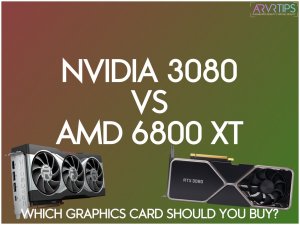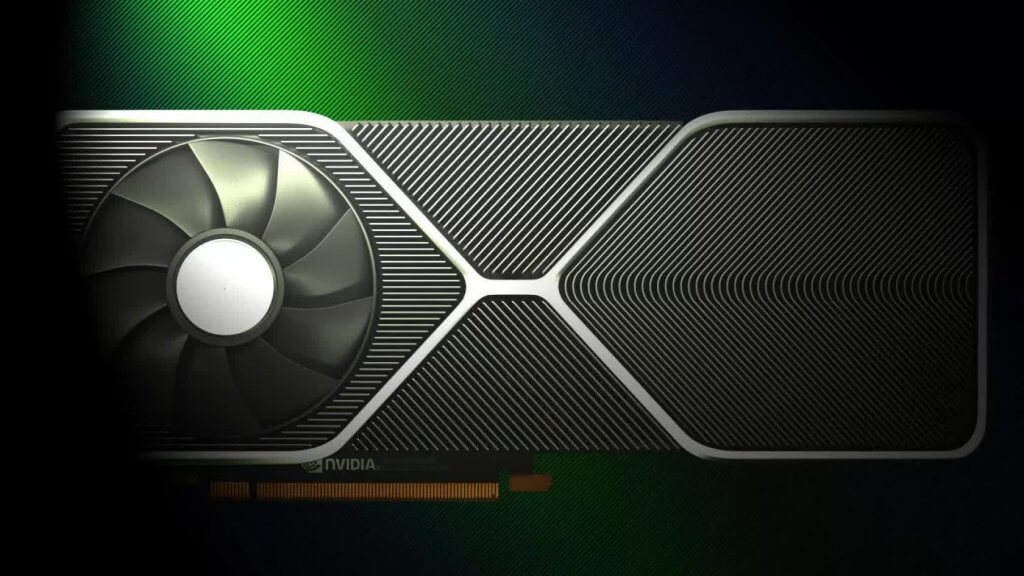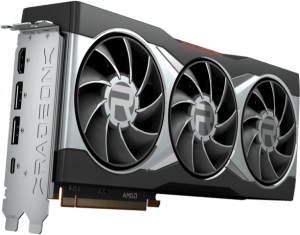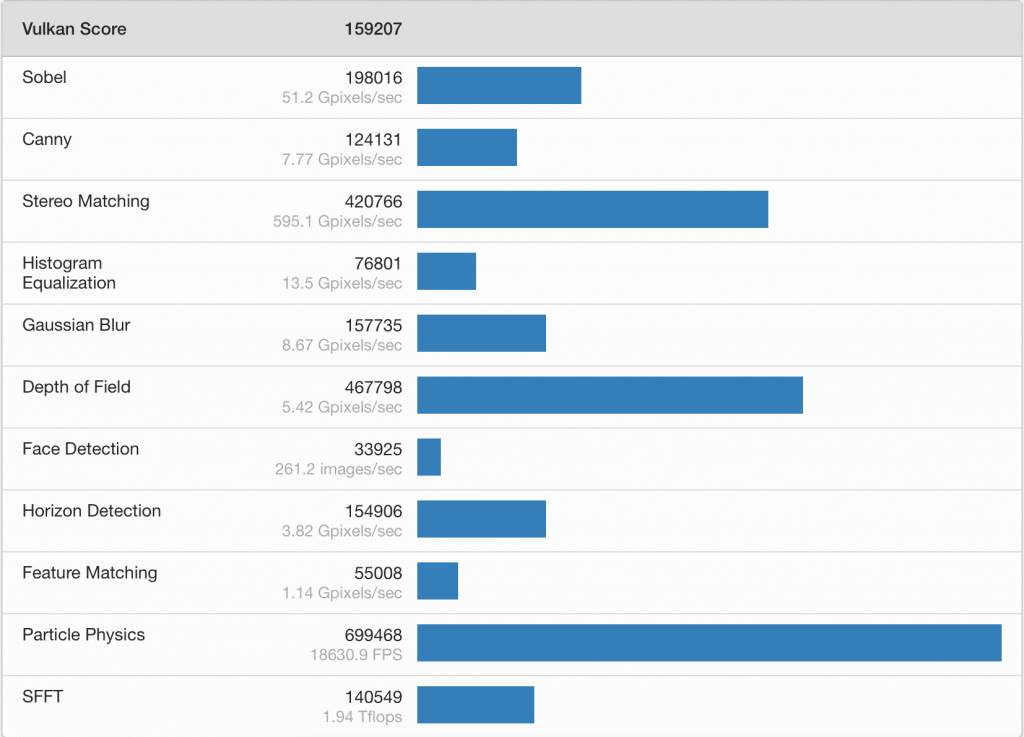Nvidia RTX 3080 vs AMD Radeon RX 6800 XT, which new graphics cards is the best for VR? In this guide, we take a look at the specs of these two GPUs side by side.
We’ll answer:
- Which graphics card is stronger: RTX 3080 vs RX 6800 XT?
- Which GPU is easier to buy?
- What features does each card have for VR?
Both the RTX 3080 and the RX 6800 XT are 2020 graphics cards. They contain optimization, efficiency and features never seen before! A lot of people are saying that this is the biggest generational gap for GPUs in a long time.
Dig in and let’s go!
- How to Buy These Graphics Cards
- Nvidia RTX 3080 vs AMD Radeon RX 6800 XT: Overview
- Similarities
- Differences
- Price
- Release Date
- CUDA Cores / Stream Processors
- Memory
- Memory Clock
- Boost Clock
- Memory Bus
- Bandwidth
- TGP
- Frames Per Second
- Geekbench Scores
- Nvidia RTX 3080 vs AMD Radeon RX 6800 XT: Quick Summary
- Final Verdict: Which Card is Better For VR?
How to Buy These Graphics Cards
After you are done reading our guide, come back here and purchase a new graphics card. We have multiple links below!
Nvidia RTX 3080
Click here to buy the Nvidia RTX 3080 Founders Edition directly from Nvidia.
No products found.
AMD Radeon RX 6800 XT
The AMD Radeon RX 6800 has not been released yet! As soon as it comes out, we will have links to buy it right here.
Nvidia RTX 3080 vs AMD Radeon RX 6800 XT: Overview
The RTX 3080 and RX 6800 are mid-upper tier 2020 graphics cards from Nvidia and AMD. They are the most common comparison for those players looking at a new GPU for VR. AMD even compared the two side by side during the unveiling of the 6800 chip.
Both of these cards are not the base model – Nvidia has the 3070 and AMD has the 6500 and 6700 in the same year lineup. As well, both cards are not the most expensive and over-the-top either – Nvidia has the 3090 and AMD has the 6900.
Before we compare the specs of the RTX 3080 vs AMD Radeon RX 6800 XT, let’s take a look at some of the similar features.
Similarities
Ray Tracing
Both the Nvidia and AMD 2020 graphics cards feature ray tracing technology support for virtual reality. Ray tracing (RT) allows light to be rendered in real-time in games. It adds an unprecedented accuracy to video games and was a big deal when it was announced.
There are a number of VR-ready games such as Fortnite, Minecraft, and more. If you are a serious virtual reality gamer, then ray tracing coming to your headset is a big deal.
4K Gaming (According to AMD)
In their keynote speech, AMD promised that the new 6800 XT would perform as well or better than the RTX 3080 in 4K gaming frames per second. They even showed off a chart that shows the frames per second in optimal settings for games such as Battlefield V, Call of Duty: Modern Warfare, Doom Eternal, Forza Horizon 4, and more.
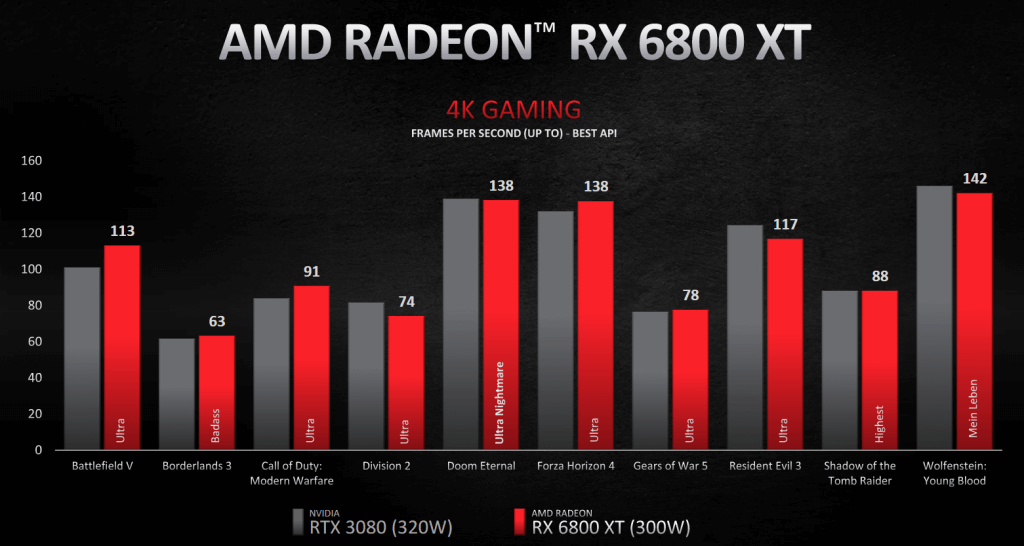
Cooling Design
Both of these new GPUs for VR went with a triple axial fan design. However, the AMD RX 6800 XT is a 2-slot design, while the Nvidia RTX 3080 is 2.5-slot. Both cards are the same 267mm long.
The 6800 XT is a better design for most PC cases, especially smaller-sized ones. You’ll want to make sure that your PC case can support the 3080 if you are thinking about going in that direction.
You wouldn’t think that card design would be a big comparison between the Nvidia RTX 3080 vs AMD Radeon RX 6800 XT in 2020, but here we are.
Differences
Smart Access Memory – AMD Only
AMD’s big new feature this year is what they call Smart Access Memory (SAM). SAM allows compatible AMD Ryzen CPUs to access all of the memory on the RX 6800 XT GPU at one time. AMD says that when you design your entire custom PC with AMD hardware, you get specs that meet or exceed Nvidia in all aspects.
Nvidia is coming out with their own version of Smart Access Memory in the future, which will integrate with specific Intel motherboards. For those that are AMD fans from front-to-back, this is one feature that gives the 6800 XT an edge.

Infinity Cache – AMD Only
AMD offers a revolutionary feature that increases the bandwidth of the chip greatly while keeping the power requirements the same. It allows Big Navi to be 30% more efficient on its own. Infinity Cash removes bottlenecks by dynamically storing information and data and doing a better job of understanding how long this information is needed.
AMD uses 128 MB of Infinity Cache on the 6800 XT, which is way more than the 4 MB included in the last generation. This patented technology provides fewer cache misses and reduced data duplication. This cache can access the main GDDR6 memory over the memory bus less often than before.
Infinity Cache holds onto a lot of temporal and spatial data that can be reused in each frame and improves power efficiency and latency. In theory, this will allow AMD to keep a higher framerate during gameplay.
Infinity Cache is a big reason why AMD promises a similar performance rating compared to Nvidia’s cards.
Deep Learning Super Sampling (DLSS) – Nvidia Only
DLSS is an Nvidia feature that gives it an edge in the RTX 3080 vs AMD Radeon 6800 comparison. Deep Learning Super Sampling uses artificial intelligence to boost the frame rate of your game without using extra power.
DLSS is mostly made for graphically-intensive games and is Nvidia’s main edge for serious gamers. Its also a really great feature for VR players to take advantage of, since VR games are more intensive.
AMD promised their version of DLSS, but it was not announced with the 6800 and 6900 graphics cards.
Next, let’s compare the Nvidia RTX 3080 vs AMD Radeon RX 6800 XT side by side for VR!
Price
For price, the AMD 6800 XT is $50 cheaper than Nvidia’s equivalent model. For those buyers who are price conscience, this might be just enough to take the edge. However, the price means nothing if it doesn’t come close in the other specs.
- Nvidia RTX 3080 = $699
- AMD Radeon 6800 XT = $649
Release Date
The release date of these two cards are:
- RTX 3080 = September 17th, 2020
- RX 6800 XT = November 18th, 2020
CUDA Cores / Stream Processors
Nvidia and AMD use different terms for the computing power of the GPU chip. The cores are responsible for processing all the data that is fed into and out of the GPU. They perform game graphics calculations that are resolved visually to the end-user.
- Nvidia CUDA Cores = 8,704
- AMD Stream Processor = 4,604
As you can see, Nvidia’s brute force CUDA Cores are the best in the industry. It means that AMD has to optimize its cores much better in order to come up with the same performance.
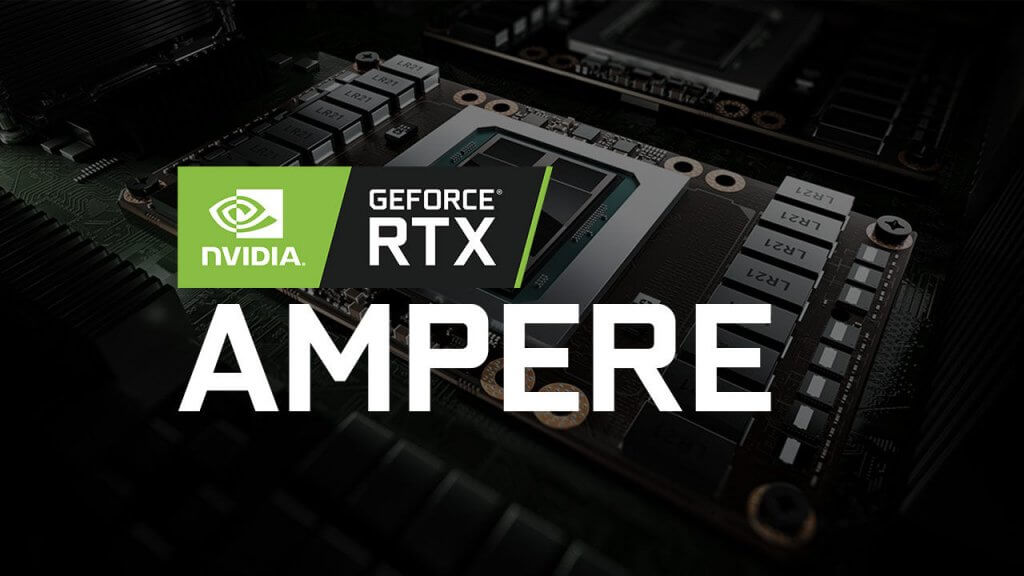
Memory
The memory is responsible for storing all the graphical information. This information is shown on the output screen. Higher memory helps the card perform at high levels. This is a main factor to consider when buying a VR-ready GPU.
Between the Nvidia RTX 3080 vs AMD Radeon RX 6800 XT:
- Nvidia RTX 3080 = 10GB DDR6X
- AMD Radeon RX 6800 XT = 16GB DDR6
Here, AMD contains much more memory packed into its chip. This allows it to store and access more information to make up for the less computing power it has. In addition, the Infinity Cache we talked about above means that AMD has to access its memory less often to begin with.
However, Nvidia utilizes DDR6X RAM, which has nearly twice the bandwidth then DDR6. The memory clock determines which card can access its memory fast, which we will take a look at next in our Nvidia RTX 3080 vs AMD Radeon RX 6800 XT guide.
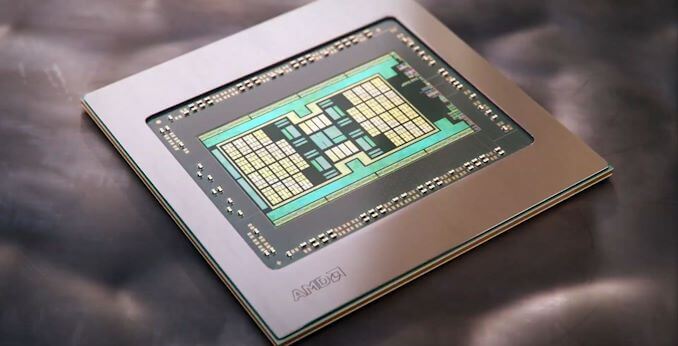
Memory Clock
The GPU memory measures millions of cycles per second. The higher clock rate you have, the higher the number of pixels that can be processed by the graphics processor every second.
The memory clock rate on these two cards are:
- Nvidia RTX 3080 = 19 GB/s
- AMD Radeon RX 6800 XT = 16 GB/s
Boost Clock
Boost clock is the overclocking speed of the device. When a graphics card notices that power and temperature have extra room from their upper limits, it automatically overclocks itself to add more performance. The boost clock for these two cards are:
- 3080 = 1710 MHz
- 6800 XT = 2250 MHz
Boost clock isn’t too much to be concerned about when looking for a VR-ready GPU.
Memory Bus
Memory bus works together with the memory on the chip to deliver information. The memory bus is the pathway that your gpu uses to access the memory it has. It works together with the memory clock speed to work out exactly how much of the memory can be accessed per second.
- Nvidia RTX 3080 = 320-bit bus
- AMD Radeon RX 6800 XT = 256-bit bus
In addition to Nvidia offering more memory, it also offers more pathways to access that memory.
Bandwidth
The memory bandwidth is the measure of speed between the graphics card and other components inside of the PC. A higher bandwidth means that the card can communicate with the computer’s CPU, memory, and other components quicker.
- RTX 3080 = 760 GB/s
- 6800 XT = 384 GB/s
Despite the Nvidia RTX 3080 being able to access other components faster, AMD promises complete synergy between their CPU and GPUs. So if you have an AMD CPU, you can expect increased performance if you buy the AMD Radeon RX 6800 XT card.
TGP
TGP stands for Total Graphics Power. Higher power output means higher temperature output, which requires extra cooling of the card and more fans. The higher the TGP of a graphics card, the greater the cooling the card will require.
The TGP of the Nvidia RTX 3080 vs AMD Radeon RX 6800 XT are:
- RTX 3080 = 320W
- RX 6800 XT = 300W
Frames Per Second
Specs are nice, but a lot of fans want to know how each card holds up in frames per second in the same game. Forbes did a really great comparison which shows the minimum and average frames per second forr each of these graphics cards while playing the same game. The computer setup was the exact same other than the GPU for each of these games:
| Game | AMD 6800 XT Minimum FPS | AMD 6800 XT Average FPS | Nvidia RTX 3080 Minimum FPS | Nvidia RTX 3080 Average FPS |
| Metro Exodus, Ultra, 2560×1440, Hairworks off, Ray Tracing on | 43 | 67 | 59 | 111 |
| Metro Exodus, Ultra, 2560×1440, Hairworks off, Ray Tracing off | 64 | 107 | 59 | 110 |
| Metro Exodus, Ultra, 4K, Hairworks off, Ray Tracing on, DLSS on | 27 | 37 | 45 | 70 |
| Metro Exodus, Ultra, 4K, Hairworks off, Ray Tracing off | 44 | 66 | 46 | 71 |
| Far Cry New Dawn, Ultra Settings, 2560×1440 | 103 | 146 | 113 | 154 |
| Far Cry New Dawn, Ultra Settings, 4K | 80 | 104 | 79 | 100 |
| Shadow of the Tomb Raider, Highest Settings, 2560×1440 | 113 | 145 | 118 | 141 |
| Shadow of the Tomb Raider, 4K, DLSS on, Ray traced shadows | 29 | 44 | 59 | 74 |
| Shadow of the Tomb Raider, 4K, RTX off | 64 | 79 | 70 | 82 |
| Wolfenstein: Youngblood, 2560×1440, Ray Tracing off | 213 | 253 | 217 | 259 |
| Wolfenstein: Youngblood, 4K, Ray Tracing off | 123 | 145 | 133 | 158 |
| Borderlands 3, High Settings, 2560×1440 | 89 | 103 | 85 | 115 |
| Borderlands 3, High Settings, 4K | 51 | 59 | 60 | 70 |
If you look at the results above, you see that Nvidia easily outperforms AMD when both ray tracing and DLSS are both turned on.
Deep Learning Super Sampling (DLSS) is Nvidia technology that uses its artificial intelligence software to boost frame rates in games that are intensive. AMD is working on a DLSS alternative, but has not released it yet.
Geekbench Scores
A few Geekbench scores comparing the Nvidia RRTX 3080 vs AMD Radeon RX 6800 XT in identical computers. Below is a comparison of the two graphics cards in the same gaming PC setup:
- Windows 10 Pro
- AMD Ryzen 9 5950X CPU
- 1 Processor, 16 Cores, 32 Threads
- 3.40 GHz base frequency
- 5.02 GHz max frequency
- 16 GB DDR4 RAM
As you can see, these two GPU score very closely. Interesting, the AMD 6800 XT holds the slight overall advantage. It has a big advance in Particle Physics, Horizon Detection, and Gaussian Blue.
Remember though, the AMD RX 6800 XT’s ideal pairing is a new Ryzen CPU. Geekbench scores of the RTX 3080 with an Intel processor running the CUDA test shows scores over 200,000! We have to wait for a bigger sample size to see how the AMD GPU performs with other CPU setups.
AMD Radeon RX 6800 XT Geekbench Score Nvidia RTX 3080 Geekbench Score
Nvidia RTX 3080 vs AMD Radeon RX 6800 XT: Quick Summary
| Nvidia RTX 3080 | AMD RX 6800 XT | |
| CUDA Cores/Stream Processors | 8,704 | 4,604 |
| Boost Clock | 1710 MHz | 2250 MHz |
| Memory | 10GB GDDR6X | 16GB DDR6X |
| Memory Clock | 19 Gbps | 16 Gbps |
| Memory Bus | 320-bit | 256-bit |
| Bandwidth | 760 GB/s | 384 GB/s |
| TGP | 320W | 300W |
| Price | $699 | $649 |
| Release Date | September 17th | November 18th |
Final Verdict: Which Card is Better For VR?
So which of these graphics cards are better for virtual reality players?
Despite AMD’s claims of being able to keep up with Nvidia, benchmark tests show that this is mostly not true. AMD does offer more memory, faster overclocking, and its Infinity Cash feature, but its higher boost clock isn’t as important for VR players.
Where the AMD 6800 XT shines is on simpler games without ray tracing that don’t get an extra edge from Nvidia’s DLSS feature.
On the other hand, Nvidia offers more CUDA Cores, which gives it a basic processing power edge. In addition, its faster memory bus and bandwidth will allow it to communicate to the rest of your gaming PC faster.
The Nvidia does cost $50 more and availability has been lower so far. However if you can get your hands on one, the RTX 3080 is a worthy VR graphics card for the next 5 years.
The only exception to this decision is if you already have an AMD CPU. In this case, you’ll see nice synergy between the CPU and a new 6800 XT graphics card. In this case, we would recommend staying with AMD for ultimate consistency.
Which card is on your wish list between the Nvidia RTX 3080 vs AMD Radeon RX 6800 XT? Comment below and let us know what you think when you compare the specs of these two graphics cards.

